
KwaZulu-Natal is a province of South Africa that was created in 1994 when the Zulu bantustan of KwaZulu and Natal Province were merged. It is located in the southeast of the country, enjoying a long shoreline beside the Indian Ocean and sharing borders with three other provinces and the countries of Mozambique, Eswatini and Lesotho. Its capital is Pietermaritzburg and its largest city is Durban. It is the 2nd most populous province in South Africa, with slightly fewer residents than Gauteng.
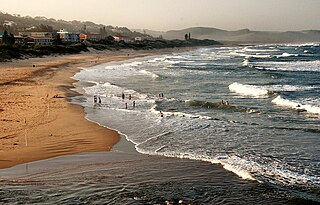
Scottburgh is a coastal resort town situated on the mouth of the Mpambanyoni River (confuser of birds). Neighbouring towns include Pennington, Renishaw, Freeland Park, Umkomaas, Sezela, Bazley, Amahlongwa, Clansthal, Park Rynie and Dududu.
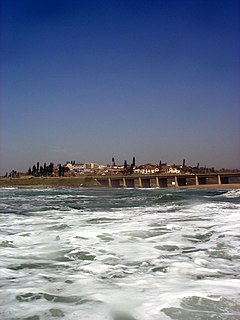
Umkomaas, a small coastal town on the subtropical south coast of KwaZulu-Natal, South Africa was formed when a harbour was built in 1861 to export sugar. The town rests beside the mouth of the navigable uMkhomazi River, also known as the Mkhomazi or Umkomaas. With the successful dredging of Durban harbour's sandbar and arrival of the railway, like Port Shepstone, the harbour fell into disuse, but the town came to life.

Westville is an area west of Durban, and a formerly independent town, in the eThekwini Metropolitan Municipality, South Africa. Westville is situated 10 km inland from the Durban CBD.

The Dlinza Forest is a subtropical forest or Coastal Scarp Forest in Eshowe, Zululand, South Africa, one of five natural forests running in a 100 km line running northwest from the coast. Others are the Ongoye, Entumeni, Nkandla and Qudeni Forests. They are the most important forests in southern Africa from the aspect of unique biodiversity. It contains rare birds, chameleons, snails, butterflies, moths, frogs and beetles. Dlinza is the home of more than 65 species of birds, including the endangered spotted ground thrush which breeds here, rare Delegorgue's pigeon, magnificent purple-crested turaco and Narina trogon.

iLembe is one of the 11 district municipalities ("districts") of KwaZulu-Natal province in South Africa. The seat of iLembe is KwaDukuza. The majority (82%) of its 606,809 people speak Zulu. The district code is DC29. It was formerly named the King Shaka District Municipality.
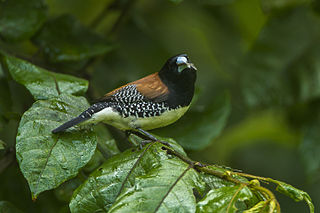
The red-backed mannikin, also known as the brown-backed mannikin or brown-backed munia, is a common species of estrildid finch found in Africa.

Junonia oenone, the blue pansy or dark blue pansy, is a Nymphalid butterfly native to Africa. "Blue pansy" is also used in India to describe Junonia orithya.
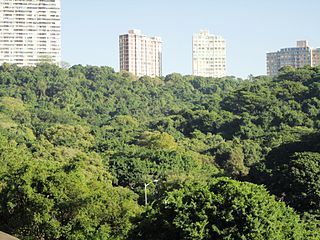
Burman Bush is a nature reserve in Morningside, Durban, situated some 8 km north of the CBD. At about 50 hectares it constitutes a small circular enclave of coastal forest which forms part of the Durban Municipal Open Space System (D'MOSS). It is the northern remnant of a forest that once covered much of the Berea ridge. The reserve's elevation varies from 19 to 133 m a.s.l.

Ilanda Wilds is a nature reserve along Amanzimtoti River in the town of Amanzimtoti, KwaZulu-Natal, South Africa. This small area of land contains various habitat types, ranging from steep rocky slopes to various riverine habitats, forest and small patches of grassland.

Pigeon Valley is a Natural Heritage Park and formally declared municipal nature reserve in Durban, South Africa. It is an unusual example of an urban reserve with very high levels of biodiversity. It was established to provide protection for the Natal Elm and other forest giants of the coastal climax forest. Another rare tree that occurs here is Natal Forest Loquat which is endemic to the Durban area and to oNgoye Forest. Pigeon Valley is about 11ha in extent, and is situated on the Berea, overlooking Durban Bay. Its unusual north-south orientation may contribute to the biodiversity, with the south-facing slope covered in canopy forest, while the north-facing slope has thorny thickets. An adjoining reservoir, previously part of the reserve, provides a patch of coastal grassland.

Areas of forest which grow in KwaZulu-Natal, South Africa mostly on south facing slopes in higher rainfall areas, and along the humid coastal areas. Different types of forest can be identified by their species composition which depends mostly on the altitude, latitude and substrate in which they grow. South facing slopes are favourable for the development of forest as they are more shaded, and therefore cooler and retain more moisture than the northern slopes. The extra moisture on the south slopes is not only favoured by forest trees, but also helps to prevent or subdue wildfires. Fires can also be blocked by cliff faces and rocks or boulders on these slopes, and by streams or rivers at the base of the slopes. The coastal regions are conducive to forest formation, because of high rainfall and humidity which are favoured by forest trees and also help to prevent or subdue fires. The rivers of the coastal areas are also broader than further inland, which may often prevent fires from spreading long distances, and fires generally burn uphill and therefore more often away from areas at low altitude.

The Hawaan Forest is situated in Umhlanga, KwaZulu-Natal, South Africa. It is a large remnant of a climax dry coastal dune forest and the last of its kind. This forest grows on a dune that dates back 18,000 years. The Hawaan forest is currently under the guardianship of the Wildlife and Environment Society of Southern Africa (WESSA), but is owned by the Tongaat Hulett Group. The property was originally owned by the Campbell family who first settled there in 1859 and the Hawaan Forest has been protected since 1860. The Hawaan Forest Estate is known for being one of the most exclusive estates in the country.

The Karkloof Forest is situated in the Karkloof Nature Reserve, 22 km north of Howick, KwaZulu-Natal, South Africa.

Junonia natalica, the Natal pansy or brown pansy, is a butterfly of the family Nymphalidae. It is found in the Afrotropic ecozone.
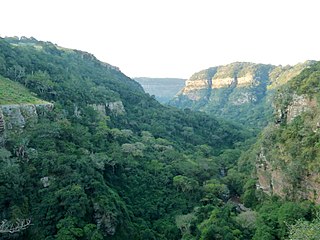
The Krantzkloof Nature Reserve, managed by Ezemvelo KZN Wildlife, conserves 668 ha of the Molweni and Nkutu River gorges that incise the sandstone Kloof plateau in KwaZulu-Natal, South Africa. The reserve conserves coastal scarp forest, sourveld grassland, a cliff face biotope, and aquatic environments along its rivers. Scarp forest is a threatened forest type, protected by South Africa's forests act of 1998, while the grassland is classified as KwaZulu-Natal sandstone sourveld, the most threatened terrestrial habitat in the Durban metropole. The reserve was established in 1950 and was augmented by land donations as late as 1999.

Magabeni is a small township to the south of Durban, in the KwaZulu-Natal province of South Africa.
The uMgeni Vlei Nature Reserve in KwaZulu-Natal, South Africa protects several threatened bird species.

Silverglen Nature Reserve is a 460 hectare conservancy on the Umlaas River in Chatsworth, Durban, KwaZulu-Natal. The reserve is the largest piece of coastal grassland and bush clump mosaic in the city, and is home to the first medicinal plant nursery in Africa, established in 1986.


















